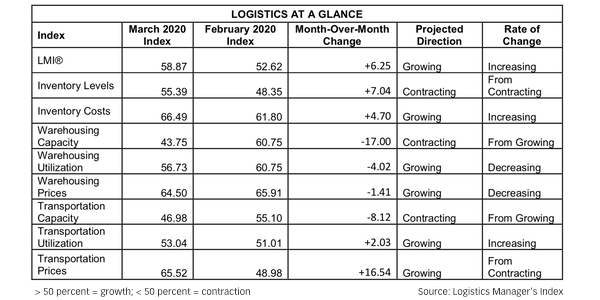Forward Thinking

By Victoria Kickham | April 3, 2020
LMI reaches its highest level in a year as demand grows for inventory, wareho
The logistics sector showed strong growth in March as the supply chain kicked into high gear to support consumer demand for supplies amid the Covid-19 pandemic, according to the March Logisticis Manager’s Index (LMI) report, released today. The March LMI registered 58.9, up 6.25 points to reach its highest level in a year.
Researchers said the March data revealed a marked change from the industry’s recent downward trend. Industry growth had been cooling, as the LMI declined but remained above the 50-point mark indicating growth in the sector and pointing to an overall slow-growth climate that seemed to have settled in among the nation’s transportation, warehousing, and logistics companies.
For now, it seems that trend has changed.
“Most of the conomy is in free-fall, but the logistics industry seems to be doing pretty well,” said LMI researcher Zac Rogers, assistant professor of supply chain management at Colorado State University, adding that today’s report breaks a two-year trend of near-constant decreases in the overall index. “While there is some evidence to suggest that this spike in logistics activity may not last, for the moment we are reporting significant resiliency across the logistics industry.”
Rogers pointed to a dramatic increase in transportation prices (up 16.54 points) and similar decreases in both warehousing and transportation capacity (down 17 points and 8.12 points respectively) as evidence of the supply channel working to keep retailers stocked to meet consumers’ demand for goods during quarantine. But he said it is unlikely to last as the economy slows due to business closures, unemployment, and consumers’ dwindling need to stock up on those household supplies.
“Now there’s no room in anyone’s warehouse because we’ve shipped so much stuff forward,” he said. “That consumer spending we saw seems to be coming down a bit, so we’re seeing this big spike in March, but I don’t think it will last.”
The LMI tracks logistics industry growth overall and across eight areas: inventory levels and costs; warehousing capacity, utilization, and prices; and transportation capacity, utilization, and prices. An LMI above 50 indicates growth in the sector; a reading below 50 indicates contraction. The report is released monthly by researchers from Arizona State University, Colorado State University, Rochester Institute of Technology, Rutgers University, and the University of Nevada, Reno, in conjunction with the Council of Supply Chain Management Professionals (CSCMP).
Visit the LMI website to participate in the monthly survey.
Victoria Kickham, an editor at large for Supply Chain Quarterly, started her career as a newspaper reporter in the Boston area before moving into B2B journalism. She has covered manufacturing, distribution and supply chain issues for a variety of publications in the industrial and electronics sectors, and now writes about everything from forklift batteries to omnichannel business trends for Supply Chain Quarterly’s sister publication, DC Velocity.
Join the Discussion
After you comment, click Post. If you’re not already logged in, you will be asked to log in or register.

Want more articles like this? Sign up for a free subscription to Supply Chain Executive Insight, a monthly e-newsletter that provides insights and commentary on supply chain trends and developments. Click here to subscribe.
We Want to Hear From You! We invite you to share your thoughts and opinions about this article by sending an e-mail to
?Subject=Letter to the Editor: Quarter : Logistics sector posts strong growth in March”>
. We will publish selected readers’ comments in future issues of CSCMP’s Supply Chain Quarterly. Correspondence may be edited for clarity or for length.
Want more articles like this? Subscribe to CSCMP’s Supply Chain Quarterly.


